Cyclic Experimental Studies on Damage Evolution Behaviors of Shale Dependent on Structural Orientations and Confining Pressures
Abstract
:1. Introduction
2. Samples, Experimental Setup and Method
2.1. Samples
2.2. Experimental Setup
2.3. Experimental Method
3. Experimental Results: Strength Properties and Failure Patterns
4. Evolutionary Behaviors of Strain Energy during the Tests
4.1. Definitions
4.2. Energy Evolution Behaviors during the Damage Process
5. Damage Variable and Damage Evolution Equation
5.1. Definition of the Damage Variable
5.2. Damage Evolution Equation
6. Conclusions
- (1)
- The evolution characteristics of the strain energy dissipation are observed for the shale samples with different oriented weak planes under different confining pressures. Under uniaxial test, the strain energy dissipation increases slowly with the increasing axial loading; under higher confining pressures, the strain energy dissipation increases slowly at the beginning process of axial loading, while there is a significant increase when the peak stress is approaching. For the shale samples with inclination angle β = 60°, the increase of the strain energy dissipation is not so significant as the cases of β = 30° and 90°.
- (2)
- These behaviors of strain energy dissipation are closely related to the different fracturing patterns of the samples under different loading directions and confining pressures. Generally speaking, the formation of extension fractures dissipates less strain energy, while the coalescence of shear fractures and the friction on the fracture surfaces dissipate much more strain energy. For the slip along the weak planes with a low friction angle, the dissipated strain energy is also limited. The different characteristics of strain energy dissipation are related to the corresponding fracturing patterns.
- (3)
- The damage evolution equation is built dependent on the loading directions and confining pressures. The damage equation shows that the damage of the shale samples increases as a power function of the axial stress. This damage evolution equation can be used for describing the damage process of the shale samples, and it can also be helpful for build constitutive equations of the shale when considering both the orientation of weak planes and various stress states.
Acknowledgments
Author Contributions
Conflicts of Interest
Appendix A. Deformation Behaviors during the Damage Process




References
- Lian, Z.; Yu, H.; Lin, T.; Guo, J. A study on casing deformation failure during multi-stage hydraulic fracturing for the stimulated reservoir volume of horizontal shale wells. J. Nat. Gas Sci. Eng. 2015, 23, 538–546. [Google Scholar] [CrossRef]
- Li, Q.; Xing, H.; Liu, J.; Liu, X. A review on hydraulic fracturing of unconventional reservoir. Petroleum 2015, 1, 8–15. [Google Scholar] [CrossRef]
- Ma, Y.; Pan, Z.; Zhong, N.; Connell, L.D.; Down, D.I.; Lin, W.; Zhang, Y. Experimental study of anisotropic gas permeability and its relationship with fracture structure of Longmaxi Shales, Sichuan Basin, China. Fuel 2016, 180, 106–115. [Google Scholar] [CrossRef]
- Niandou, H.; Shao, J.; Henry, J.; Fourmaintraux, D. Laboratory investigation of the mechanical behaviour of Tournemire shale. Int. J. Rock Mech. Min. Sci. 1997, 34, 3–16. [Google Scholar] [CrossRef]
- Brown, S.R.; Bruhn, R.L. Fluid permeability of deformable fracture networks. J. Geophys. Res. Solid Earth 1998, 103, 2489–2500. [Google Scholar] [CrossRef]
- Jaeger, J.C. Shear Failure of Anistropic Rocks. Geol. Mag. 1960, 97, 65–72. [Google Scholar] [CrossRef]
- McLamore, R.T.; Gray, K.E. A Strength Criterion for Anisotropic Rocks Based Upon Experimental Observations. In Proceedings of the Annual Meeting of the American Institute of Mining, Metallurgical, and Petroleum Engineers, Los Angeles, CA, USA, 19–23 February 1967. [Google Scholar]
- Crawford, B.R.; Dedontney, N.L.; Alramahi, B.; Ottesen, S. Shear strength anisotropy in fine-grained rocks. In Proceedings of the 46th US Rock Mechanics/Geomechanics Symposium, Chicago, IL, USA, 24–27 June 2012. [Google Scholar]
- Fjær, E.; Nes, O.-M. The Impact of Heterogeneity on the Anisotropic Strength of an Outcrop Shale. Rock Mech. Rock Eng. 2014, 47, 1603–1611. [Google Scholar] [CrossRef]
- Gao, Z.; Zhao, J.; Yao, Y. A generalized anisotropic failure criterion for geomaterials. Int. J. Solids Struct. 2010, 47, 3166–3185. [Google Scholar] [CrossRef]
- Laloui, L.; Salager, S.; Nuth, M.; Marschall, P. Anisotropic mechanical response of a shale. In Proceedings of the EAGE Shale Workshop 2010: Shale—Resource & Challenge, Nice, France, 26–28 April 2010. [Google Scholar]
- Rezapour, A. Modeling of Mechanical Behaviour of Anisotropic Rocks. Master Degree Thesis, McMaster University, Hamilton, ON, Canada, 2015. [Google Scholar]
- Zhang, Z.; Zhang, R.; Xie, H.; Liu, J.; Were, P. Differences in the acoustic emission characteristics of rock salt compared with granite and marble during the damage evolution process. Environ. Earth Sci. 2015, 73, 6987–6999. [Google Scholar] [CrossRef]
- Ghamgosar, M.; Erarslan, N.; Williams, D.J. Evolution of Damage on Tensile Fracturing of Rock by Means of Elastic Ultrasonic Wave Velocity. Proceedings of Eurock, Vigo, Spain, 27–29 May 2014; pp. 297–302. [Google Scholar]
- Feng, X.T.; Chen, S.; Zhou, H. Real-time computerized tomography (CT) experiments on sandstone damage evolution during triaxial compression with chemical corrosion. Int. J. Rock Mech. Min. Sci. 2004, 41, 181–192. [Google Scholar] [CrossRef]
- Zhou, X.P.; Zhang, Y.X.; Ha, Q.L. Real-time computerized tomography (CT) experiments on limestone damage evolution during unloading. Theor. Appl. Fract. Mech. 2008, 50, 49–56. [Google Scholar] [CrossRef]
- Song, D.; Wang, E.; Li, Z.; Liu, J.; Xu, W. Energy dissipation of coal and rock during damage and failure process based on EMR. Int. J. Min. Sci. Technol. 2015, 25, 787–795. [Google Scholar] [CrossRef]
- Qiu, S.-L.; Feng, X.-T.; Xiao, J.-Q.; Zhang, C.-Q. An Experimental Study on the Pre-Peak Unloading Damage Evolution of Marble. Rock Mech. Rock Eng. 2014, 47, 401–419. [Google Scholar] [CrossRef]
- Martin, C.D.; Chandler, N.A. The progressive fracture of Lac du Bonnet granite. Int. J. Rock Mech. Min. Sci. Geomech. Abstr. 1994, 31, 643–659. [Google Scholar] [CrossRef]
- Yoshinaka, R.; Tran, T.V.; Osada, M. Non-linear, stress- and strain-dependent behavior of soft rocks under cyclic triaxial conditions. Int. J. Rock Mech. Min. Sci. 1998, 35, 941–955. [Google Scholar] [CrossRef]
- Li, D.; Sun, Z.; Xie, T.; Li, X.; Ranjith, P.G. Energy evolution characteristics of hard rock during triaxial failure with different loading and unloading paths. Eng. Geol. 2017, 228, 270–281. [Google Scholar] [CrossRef]
- Wang, P.; Xu, J.; Fang, X.; Wang, P. Energy dissipation and damage evolution analyses for the dynamic compression failure process of red-sandstone after freeze-thaw cycles. Eng. Geol. 2017, 221, 104–113. [Google Scholar] [CrossRef]
- Peng, R.; Ju, Y.; Wang, J.G.; Xie, H.; Gao, F.; Mao, L. Energy Dissipation and Release During Coal Failure Under Conventional Triaxial Compression. Rock Mech. Rock Eng. 2015, 48, 509–526. [Google Scholar] [CrossRef]
- Xie, H.P.; Li, L.Y.; Ju, Y.; Peng, R.D.; Yang, Y.M. Energy analysis for damage and catastrophic failure of rocks. Sci. China Technol. Sci. 2011, 54, 199–209. [Google Scholar] [CrossRef]
- Denney, D. Thirty Years of Gas-Shale Fracturing: What Have We Learned? J. Pet. Technol. 2010, 62, 88–90. [Google Scholar] [CrossRef]
- Jarvie, D.M.; Hill, R.J.; Ruble, T.E.; Pollastro, R.M. Unconventional shale-gas systems: The Mississippian Barnett Shale of north-central Texas as one model for thermogenic shale-gas assessment. AAPG Bull. 2007, 91, 475–499. [Google Scholar] [CrossRef]
- Wang, J.; Liu, Y. Simulation Based Well Performance Modeling in Haynesville Shale Reservoir. In Proceedings of the SPE Production and Operations Symposium, Oklahoma City, OK, USA, 27–29 March 2011. [Google Scholar]
- Song, D.; Wang, E.; Liu, J. Relationship between EMR and dissipated energy of coal rock mass during cyclic loading process. Saf. Sci. 2012, 50, 751–760. [Google Scholar] [CrossRef]
- Ke, W.; Chuang, Z. Experimental study of energy dissipation and damage variable before and after destruction of rock subjected to cyclic loading. Electron. J. Geotech. Eng. 2013, 18, 3979–3985. [Google Scholar]
- Huang, D.; Li, Y. Conversion of strain energy in Triaxial Unloading Tests on Marble. Int. J. Rock Mech. Min. Sci. 2014, 66, 160–168. [Google Scholar] [CrossRef]
- Li, M.; Mao, X.; Lu, A.; Tao, J.; Zhang, G.; Zhang, L.; Li, C. Effect of specimen size on energy dissipation characteristics of red sandstone under high strain rate. Int. J. Min. Sci. Technol. 2014, 24, 151–156. [Google Scholar] [CrossRef]
- Zhao, G.-Y.; Dai, B.; Dong, L.-J.; Yang, C. Energy conversion of rocks in process of unloading confining pressure under different unloading paths. Trans. Nonferr. Met. Soc. China 2015, 25, 1626–1632. [Google Scholar] [CrossRef]
- Li, Q.M. Strain energy density failure criterion. Int. J. Solids Struct. 2001, 38, 6997–7013. [Google Scholar] [CrossRef]
- Cho, J.-W.; Kim, H.; Jeon, S.; Min, K.-B. Deformation and strength anisotropy of Asan gneiss, Boryeong shale, and Yeoncheon schist. Int. J. Rock Mech. Min. Sci. 2012, 50, 158–169. [Google Scholar] [CrossRef]
- Fjær, E.; Nes, O.M. Strength Anisotropy of Mancos Shale. In Proceedings of the 47th US Rock Mechanics/Geomechanics Symposium, San Francisco, CA, USA, 23–26 June 2013. [Google Scholar]
- Jia, C.G.; Chen, J.H.; Guo, Y.T.; Yang, C.H.; Xu, J.B.; Wang, L. Research on mechanical behaviors and failure modes of layer shale. Rock Soil Mech. 2013, 34, 57–61. [Google Scholar]
- Chen, T.; Feng, X.; Zhang, X.; Cao, W.; Fu, C. Experimental study on mechanical and anisotropic properties of black shale. Chin. J. Rock Mech. Eng. 2014, 33, 1772–1779. [Google Scholar]
- Sang, Y.; Yang, S.; Zhao, F.; Hou, B. Research on anisotropy and failure characteristics of southern marine shale rock. Drill. Prod. Technol. 2015, 38, 71–74. [Google Scholar]
- Wu, Y.; Li, X.; He, J.; Zheng, B. Mechanical Properties of Longmaxi Black Organic-Rich Shale Samples from South China under Uniaxial and Triaxial Compression States. Energies 2016, 9, 1088. [Google Scholar] [CrossRef]
- Hoek, E.; Brown, E.T. Empirical strength criterion for rock masses. J. Geotech. Eng. Div. 1980, 106, 1013–1035. [Google Scholar]
- Cheng, C.; Li, X.; Qian, H. Anisotropic Failure Strength of Shale with Increasing Confinement: Behaviors, Factors and Mechanism. Materials 2017, 10, 1310. [Google Scholar] [CrossRef] [PubMed]
- Kidybiński, A. Bursting liability indices of coal. Int. J. Rock Mech. Min. Sci. Geomech. Abstr. 1981, 18, 295–304. [Google Scholar] [CrossRef]
- Hucka, V.; Das, B. Brittleness determination of rocks by different methods. Int. J. Rock Mech. Min. Sci. Geomech. Abstr. 1974, 11, 389–392. [Google Scholar] [CrossRef]
- Xie, H.P.; Yang, J.U.; Li-Yun, L.I. Criteria for strength and structural failure of rocks based on energy dissipation and energy release principles. Chin. J. Rock Mech. Eng. 2005, 24, 3003–3010. [Google Scholar]
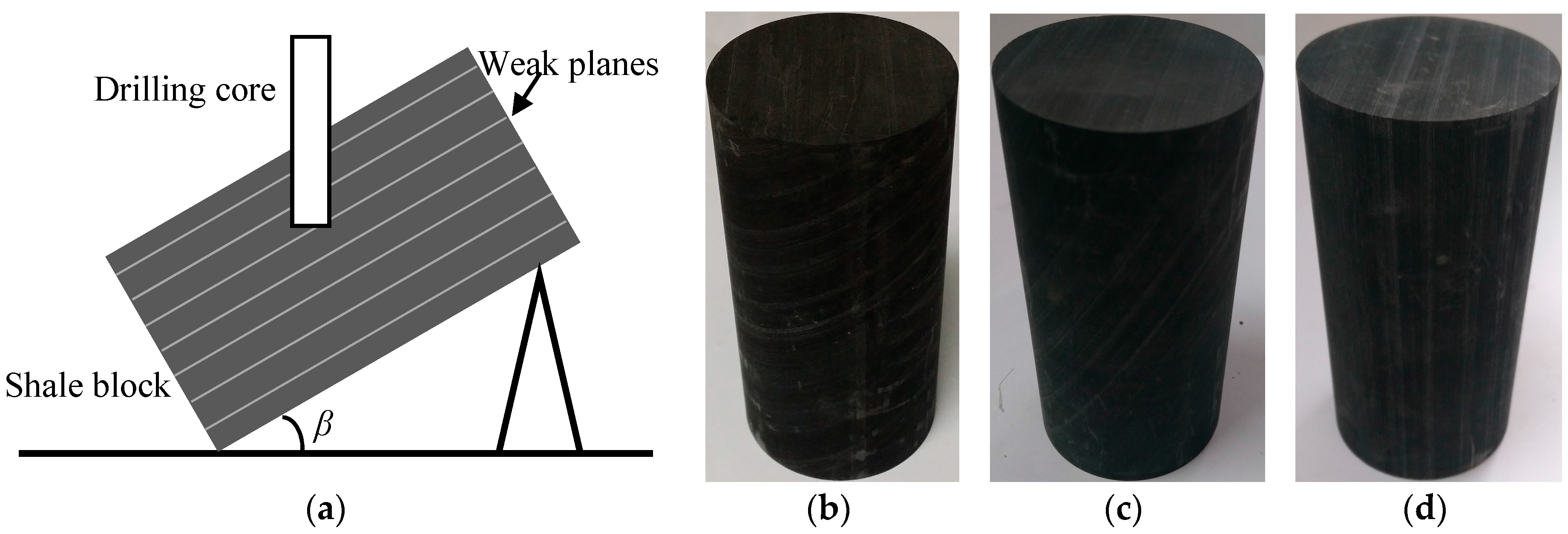



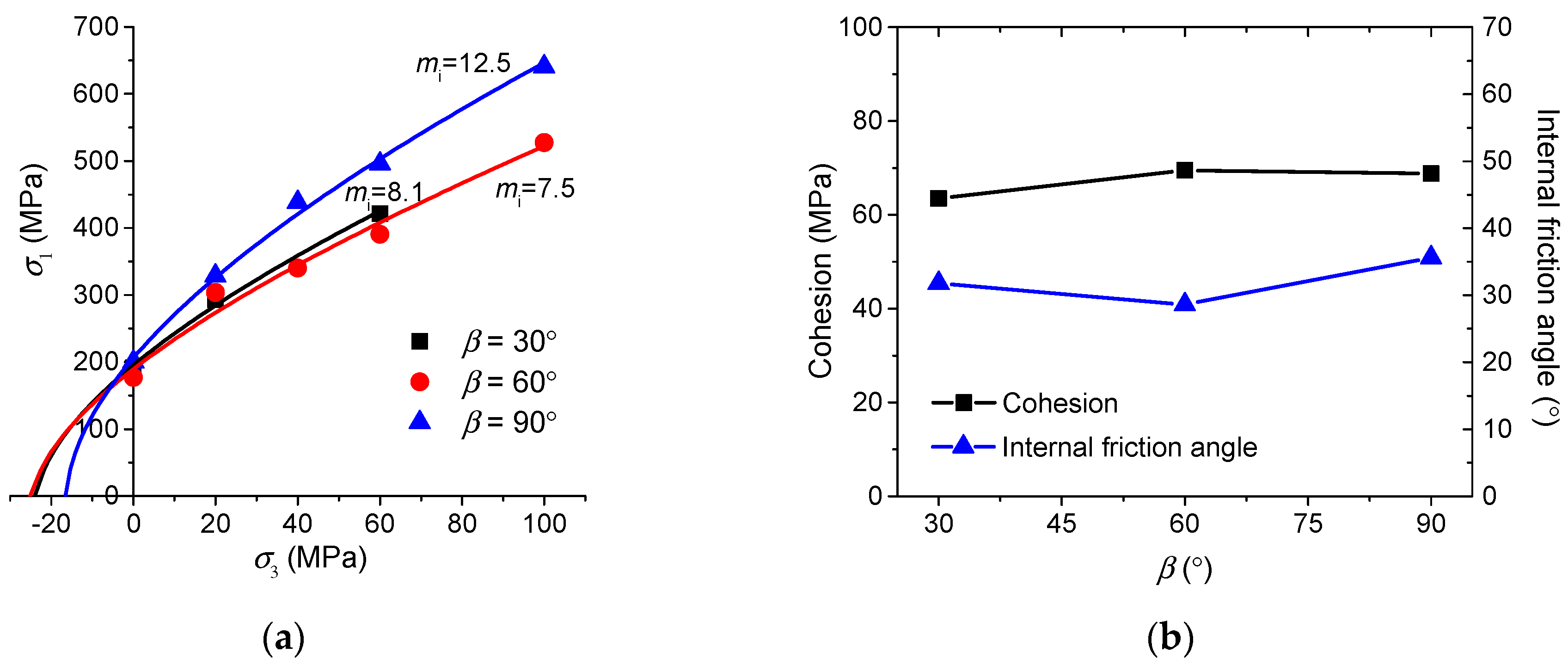
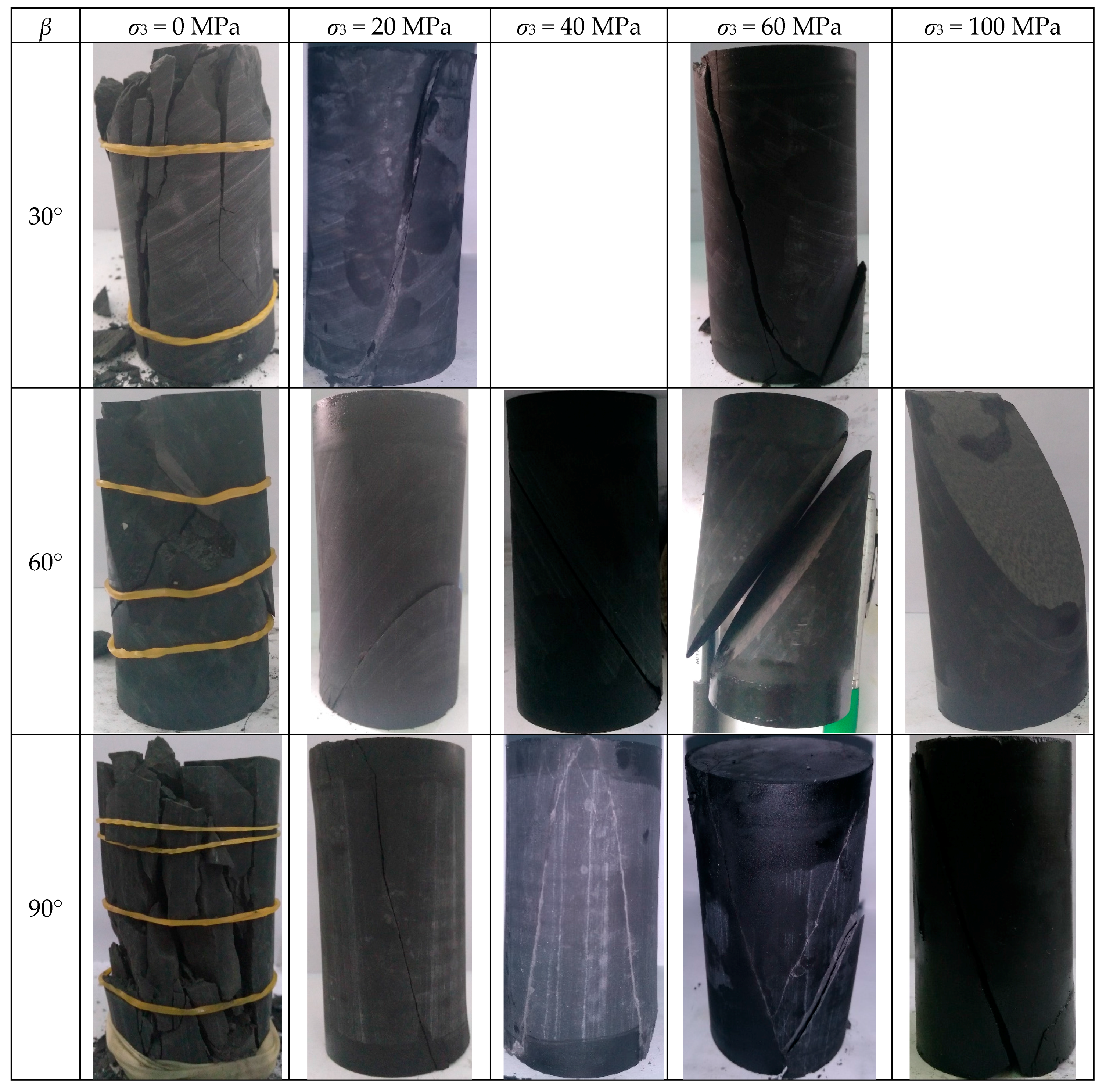
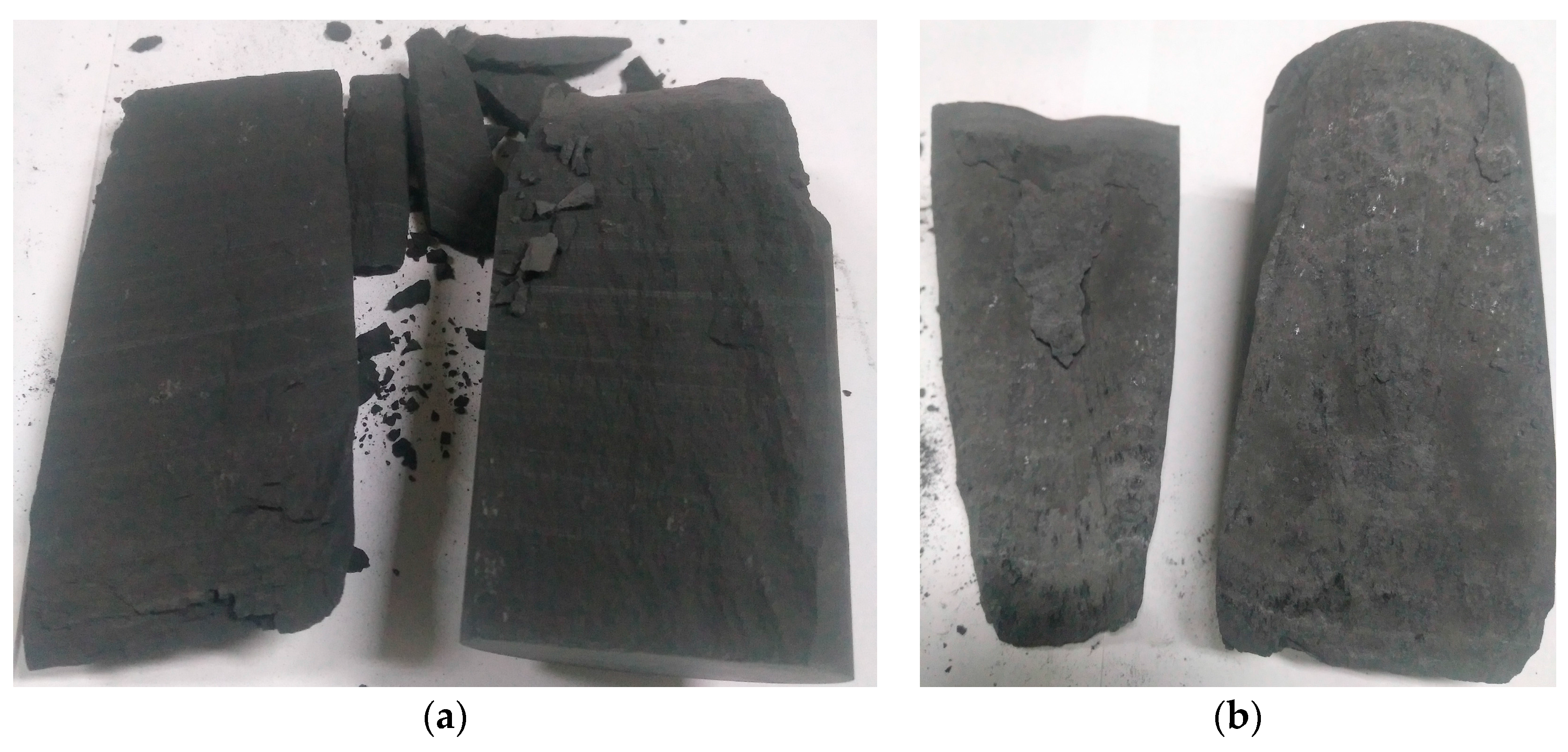
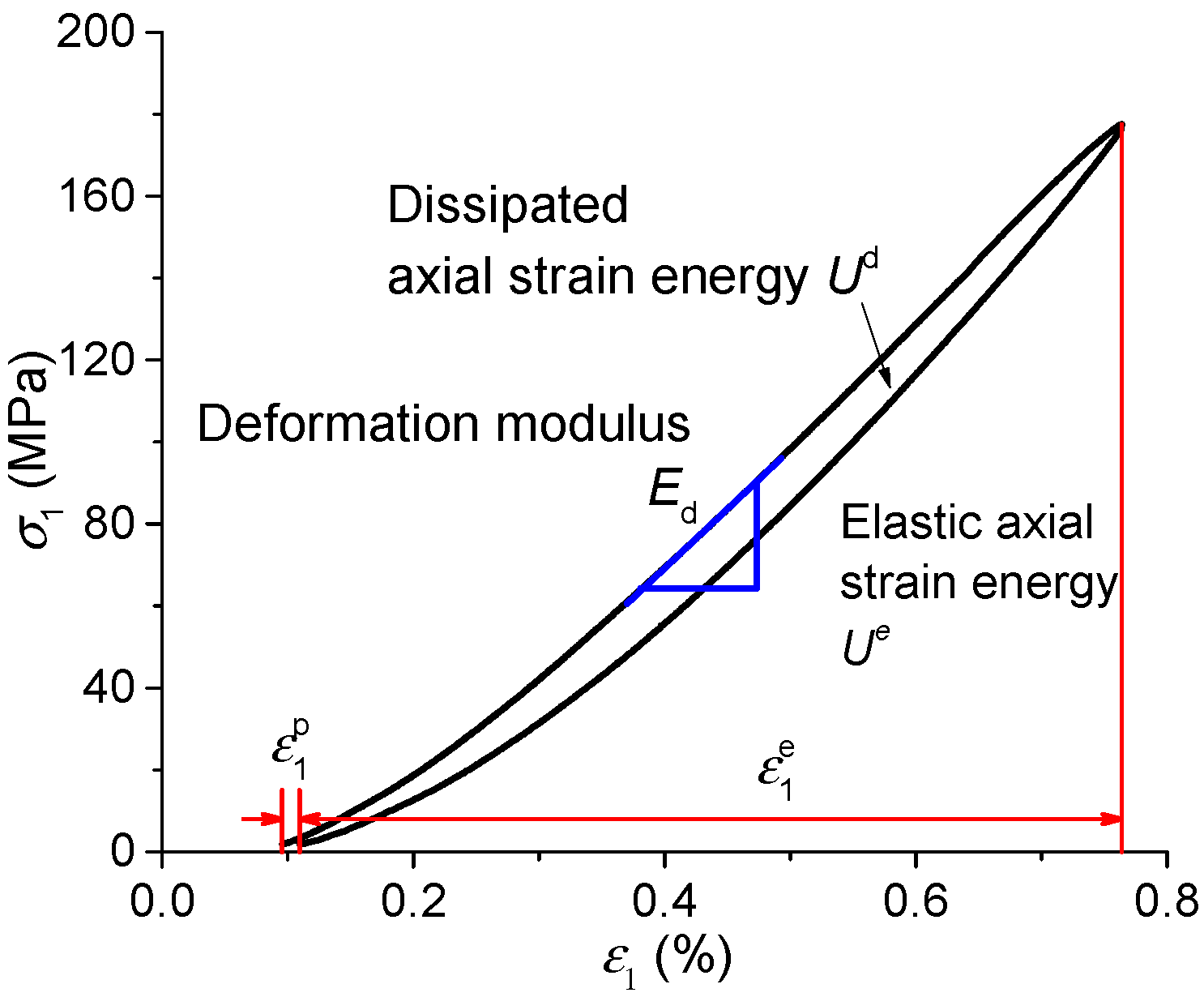

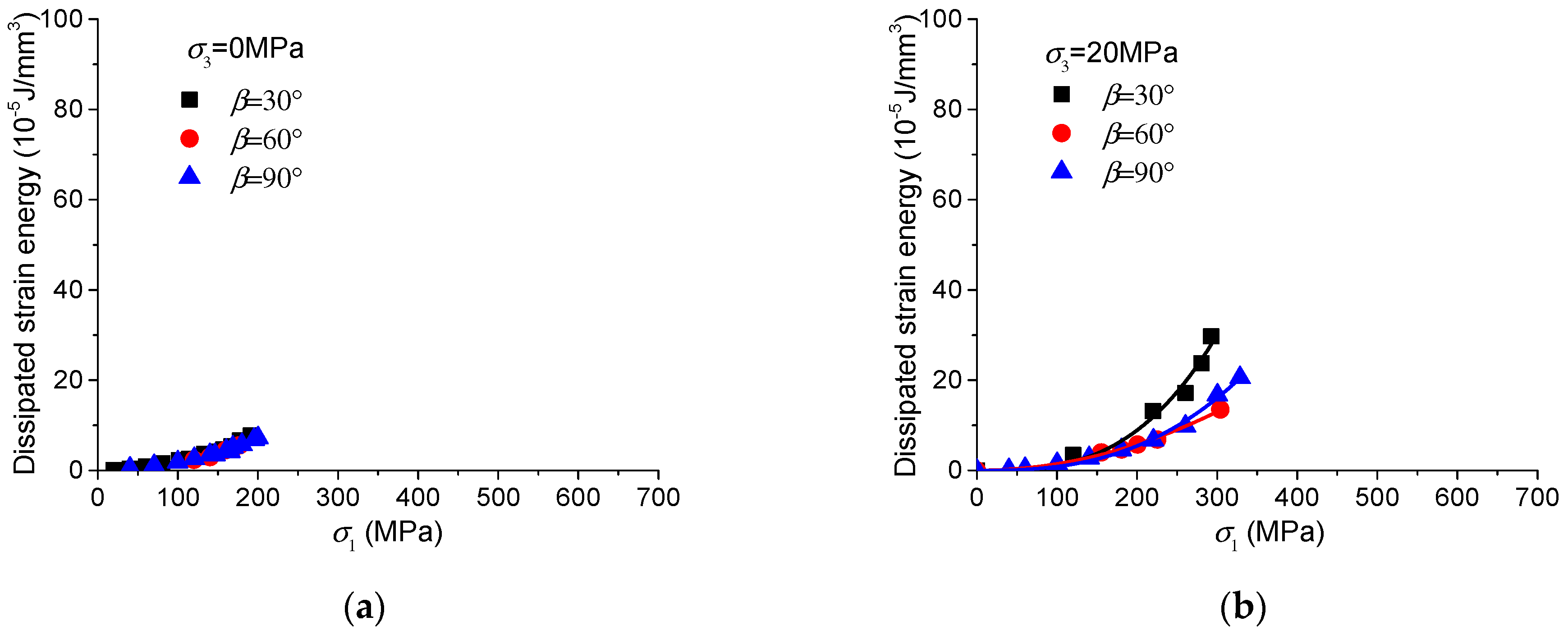

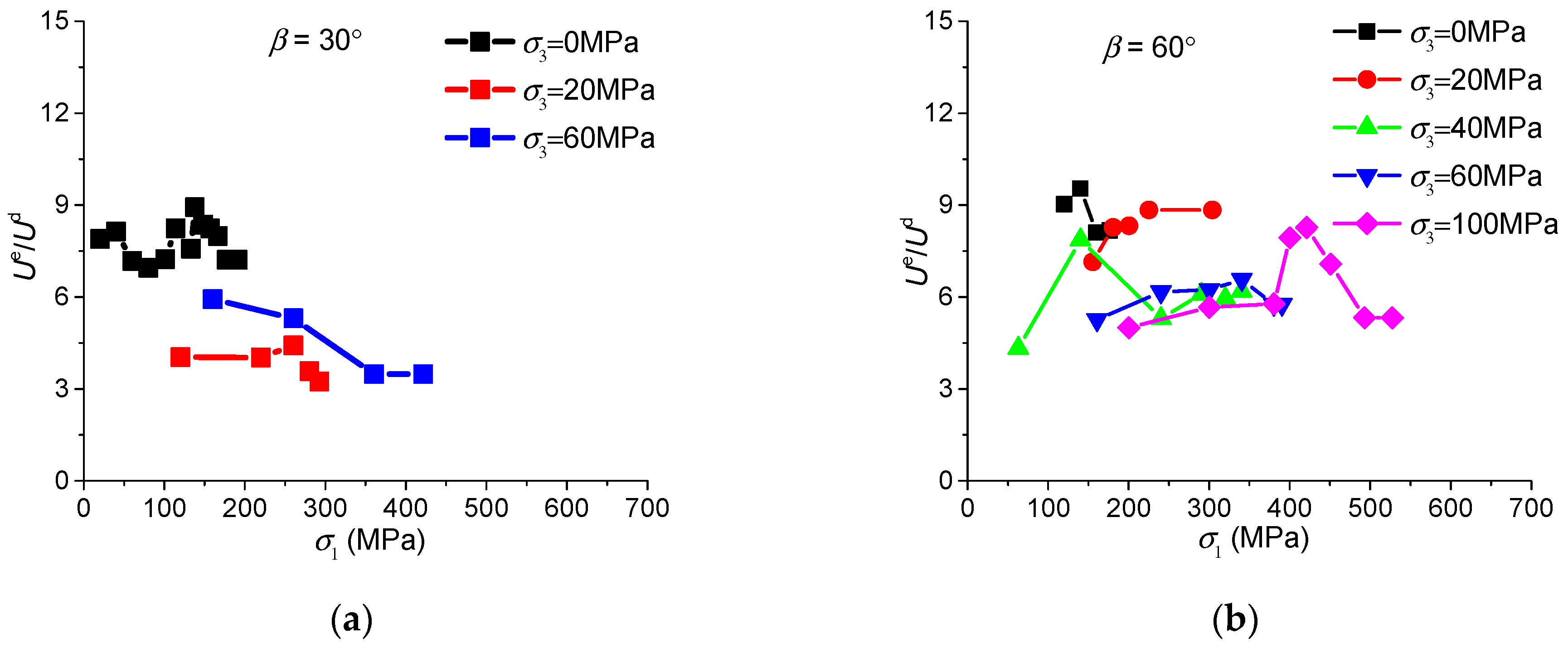
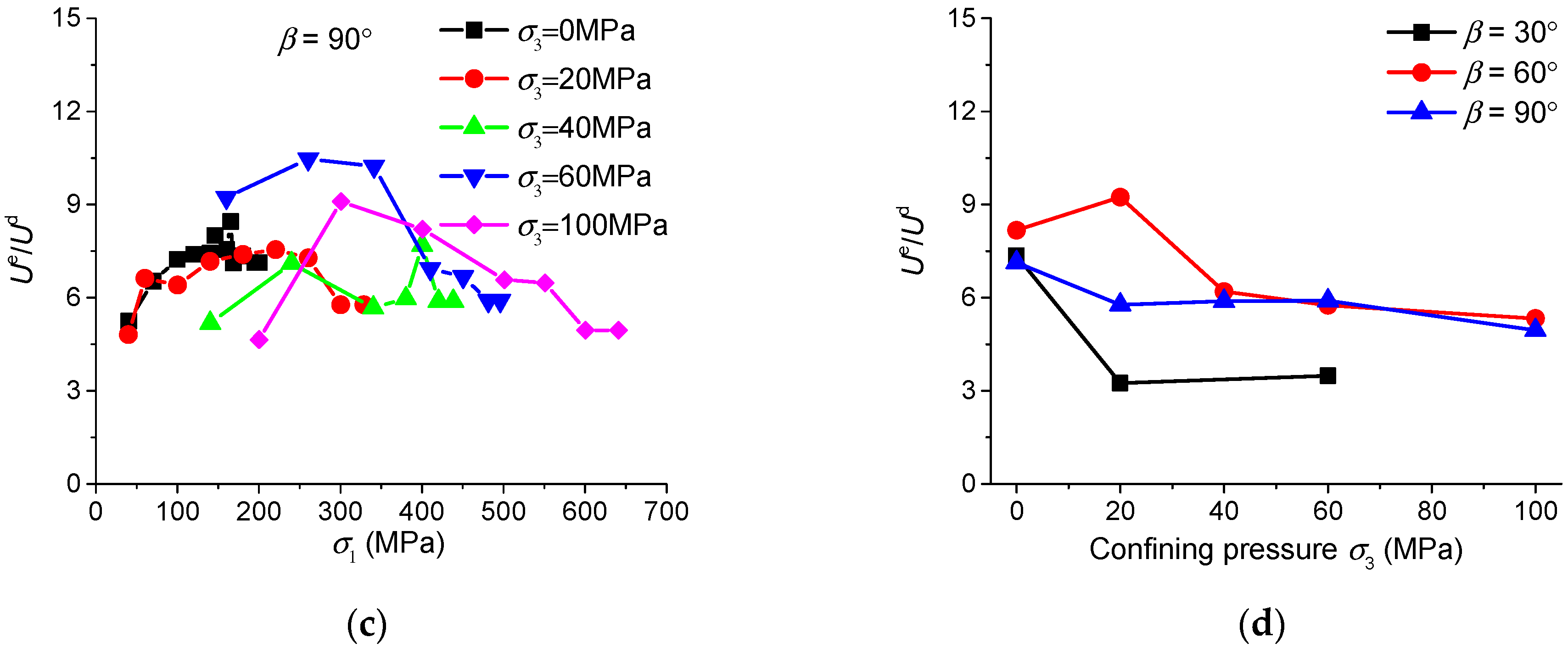

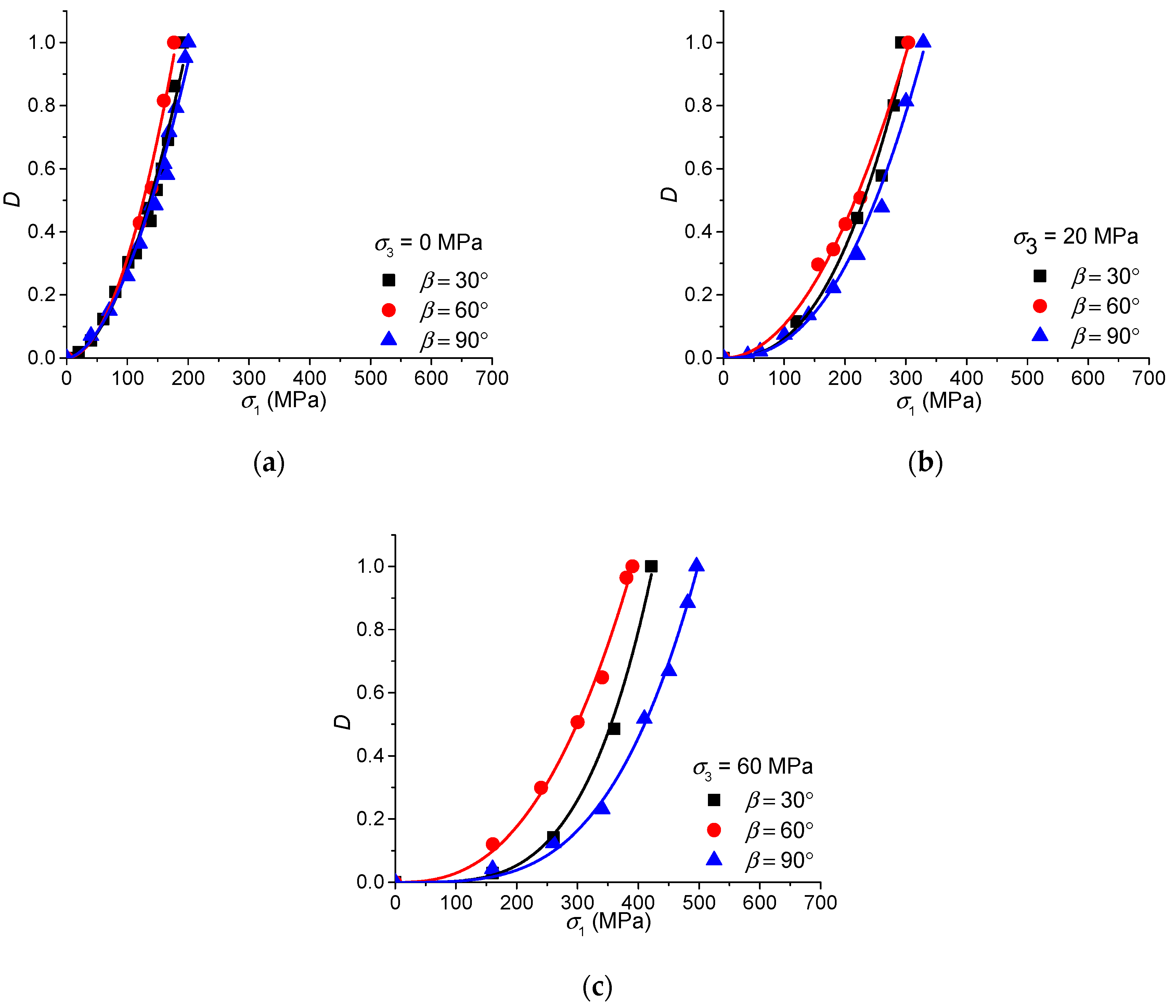
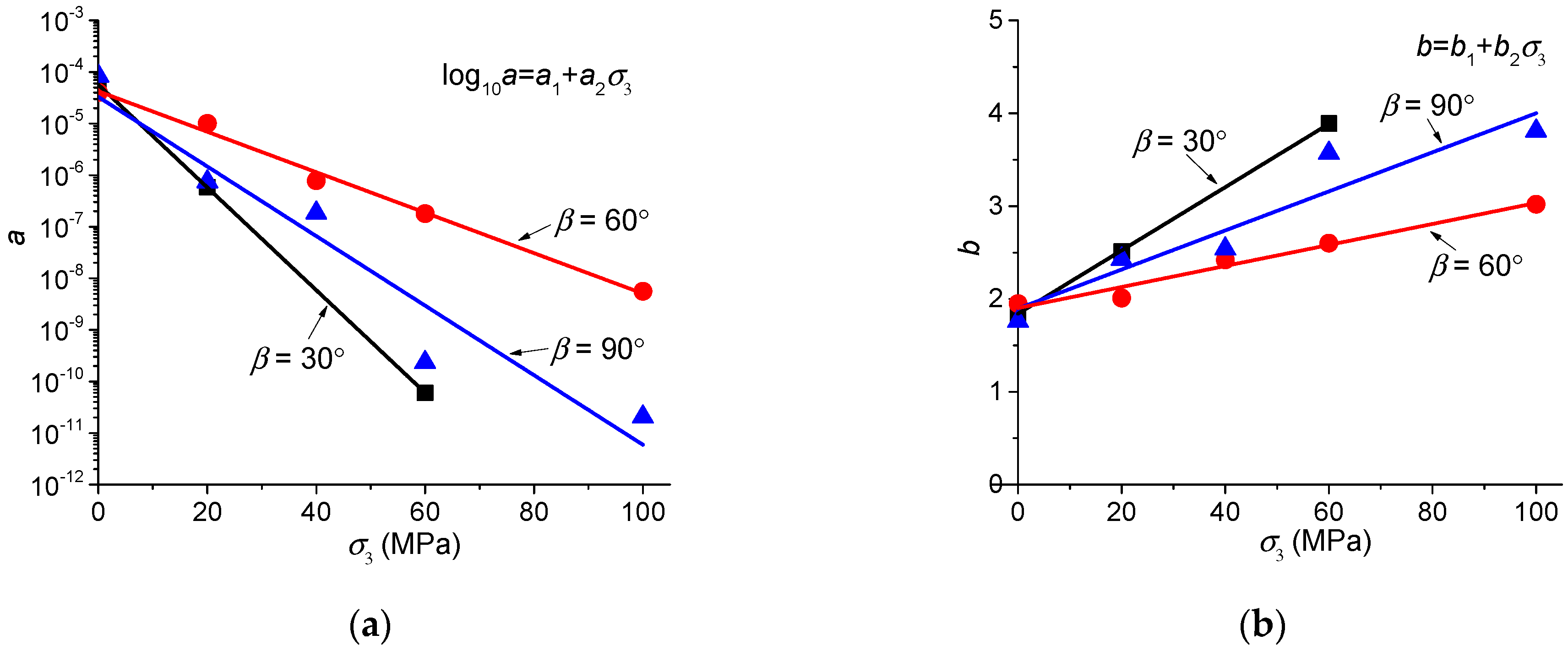
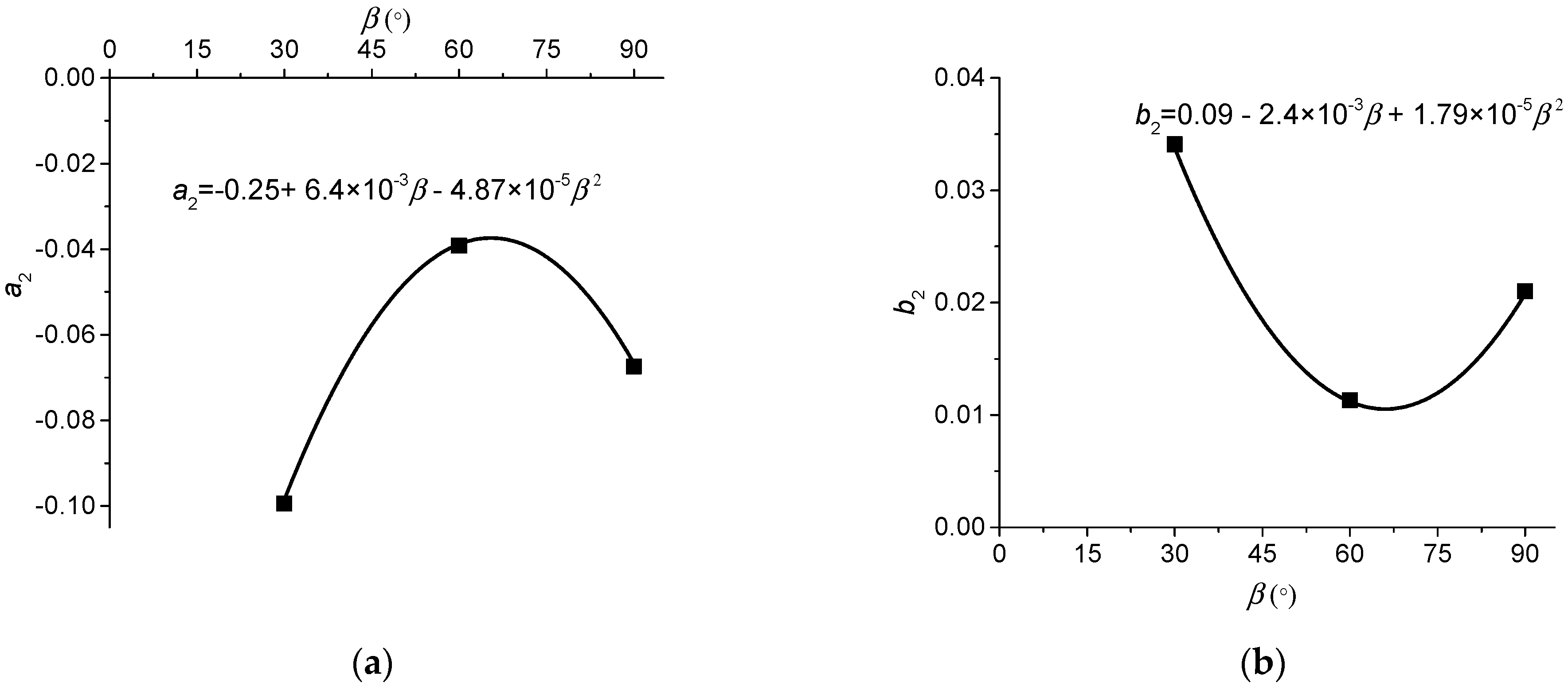
| β (°) | Sample No. | Diameter (mm) | Height (mm) | Bulk Density (g/cm3) | P-Wave Velocity (m/s) |
|---|---|---|---|---|---|
| 30 | S30-0 | 49.35 | 100.02 | 2.73 | 4311.4 |
| S30-20 | 49.41 | 99.96 | 2.73 | 4384.2 | |
| S30-60 | 49.63 | 99.96 | 2.70 | 4384.4 | |
| 60 | S60-0 | 49.52 | 99.92 | 2.73 | 4683.6 |
| S60-20 | 49.57 | 99.90 | 2.73 | 4712.4 | |
| S60-40 | 49.51 | 99.70 | 2.73 | 4762.7 | |
| S60-60 | 49.44 | 99.90 | 2.73 | 4712.4 | |
| S60-100 | 49.47 | 100.02 | 2.73 | 4659.3 | |
| 90 | S90-0 | 49.52 | 100.04 | 2.73 | 4903.9 |
| S90-20 | 49.39 | 100.07 | 2.75 | 4905.6 | |
| S90-40 | 49.52 | 100.04 | 2.74 | 5002.0 | |
| S90-60 | 49.40 | 99.96 | 2.75 | 5099.8 | |
| S90-100 | 49.46 | 100.09 | 2.74 | 4906.2 |
| β (°) | Sample No. | Confinement σ3 (MPa) | Peak Axial Stress (MPa) | Peak Axial Strain (%) |
|---|---|---|---|---|
| 30 | S30-0 | 0 | 191.3 | 0.82 |
| S30-20 | 20 | 292.6 | 1.12 | |
| S30-60 | 60 | 421.5 | 1.44 | |
| 60 | S60-0 | 0 | 176.6 | 0.65 |
| S60-20 | 20 | 303.9 | 0.92 | |
| S60-40 | 40 | 340.2 | 0.99 | |
| S60-60 | 60 | 390.4 | 1.00 | |
| S60-100 | 100 | 527.4 | 1.37 | |
| 90 | S90-0 | 0 | 200.2 | 0.77 |
| S90-20 | 20 | 328.6 | 0.98 | |
| S90-40 | 40 | 438.4 | 1.21 | |
| S90-60 | 60 | 495.2 | 1.35 | |
| S90-100 | 100 | 640.9 | 1.59 |
| β (°) | σ3 (MPa) | a | b | R2 |
|---|---|---|---|---|
| 30 | 0 | 5.58 × 10−5 | 1.85 | 0.9845 |
| 20 | 5.87 × 10−7 | 2.51 | 0.9749 | |
| 60 | 6.00 × 10−11 | 3.89 | 0.9961 | |
| 60 | 0 | 3.99 × 10−5 | 1.95 | 0.9866 |
| 20 | 1.01 × 10−5 | 2.01 | 0.9948 | |
| 40 | 7.78 × 10−7 | 2.42 | 0.9906 | |
| 60 | 1.80 × 10−7 | 2.60 | 0.9943 | |
| 100 | 5.60 × 10−9 | 3.02 | 0.9505 | |
| 90 | 0 | 8.37 × 10−5 | 1.76 | 0.9838 |
| 20 | 7.44 × 10−7 | 2.43 | 0.9913 | |
| 40 | 1.86 × 10−7 | 2.54 | 0.9658 | |
| 60 | 2.34 × 10−10 | 3.57 | 0.9961 | |
| 100 | 2.05 × 10−11 | 3.81 | 0.9907 |
| β (°) | ||||||
|---|---|---|---|---|---|---|
| a1 | a2 | R2 | b1 | b2 | R2 | |
| 30 | −4.2484 | −0.0995 | 0.9999 | 1.8414 | 0.0341 | 0.9998 |
| 60 | −4.3748 | −0.0392 | 0.9917 | 1.9020 | 0.0113 | 0.9639 |
| 90 | −4.4838 | −0.0674 | 0.9096 | 1.8962 | 0.0210 | 0.8730 |
© 2018 by the authors. Licensee MDPI, Basel, Switzerland. This article is an open access article distributed under the terms and conditions of the Creative Commons Attribution (CC BY) license (http://creativecommons.org/licenses/by/4.0/).
Share and Cite
Cheng, C.; Li, X. Cyclic Experimental Studies on Damage Evolution Behaviors of Shale Dependent on Structural Orientations and Confining Pressures. Energies 2018, 11, 160. https://doi.org/10.3390/en11010160
Cheng C, Li X. Cyclic Experimental Studies on Damage Evolution Behaviors of Shale Dependent on Structural Orientations and Confining Pressures. Energies. 2018; 11(1):160. https://doi.org/10.3390/en11010160
Chicago/Turabian StyleCheng, Cheng, and Xiao Li. 2018. "Cyclic Experimental Studies on Damage Evolution Behaviors of Shale Dependent on Structural Orientations and Confining Pressures" Energies 11, no. 1: 160. https://doi.org/10.3390/en11010160
APA StyleCheng, C., & Li, X. (2018). Cyclic Experimental Studies on Damage Evolution Behaviors of Shale Dependent on Structural Orientations and Confining Pressures. Energies, 11(1), 160. https://doi.org/10.3390/en11010160




